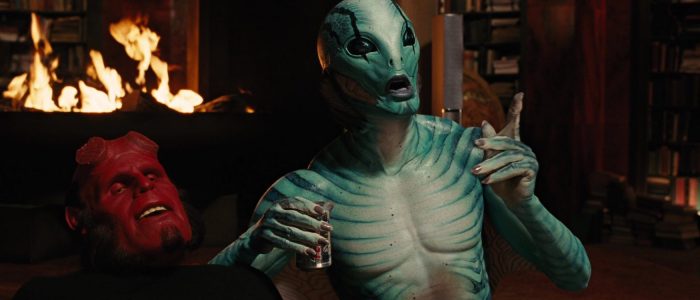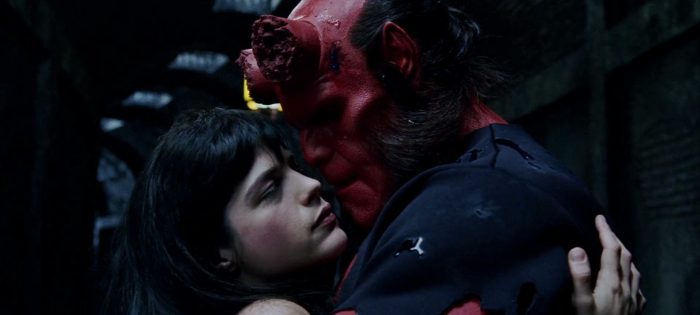Guillermo Del Toro's Vision For 'Hellboy' Gave Us A Rare Pair Of Truly Auteur-Driven Superhero Films
It's only been fifteen years since Oscar-winning director Guillermo del Toro and frequent collaborator Ron Perlman introduced moviegoers to the sight of a trenchcoated, gun-toting red demon with horns filed down to stumps on his head. The 2004 Hellboy and especially its sequel, Hellboy II: The Golden Army, sometimes stray into sentimentalism in a way that puts them at odds, tonally, with creator Mike Mignola's original Hellboy comics, which were more pulp horror adventures. Yet it's their whimsical touches — the soulful monsters, the hidden fairy tale realms, the character-based humor, and yes, even the occasional sing-along — that give these films their charm.
The new R-rated Hellboy reboot, starring David Harbour of Stranger Things, hits theaters on Friday and Mignola and Harbour have been touting it as more loyal to the comics. It's understandable why they would make that a selling point for fans. While the look of Perlman's Hellboy remains one of the better live-action visualizations of a comics character that there's ever been, del Toro's films weren't slavish adaptations. More fantasy than pulp, they were arguably truer to the spirit of his filmography than their own source material. However, that overlap is precisely what makes them interesting and worth revisiting.
Most comic book movies favor the franchise over the filmmaker. This is a symptom of the current cinema landscape as a whole. But with comic book movies, in particular, there's often a burden of legacy that leaves filmmakers acting as stewards for years of shared-universe ties and decades of publication history. There are certainly examples you could rattle off where a director's unmistakable identity has shone through the studio product, but this is something different from having an overriding influence on that product.
That's what makes del Toro's two Hellboy movies look so unique, especially in the month of April 2019, when we've got this rebooted version of Hellboy coming at us, sandwiched between the lightning-bolt success of Shazam! and the historic, 22-film culmination that is the upcoming Avengers: Endgame. Like Christopher Nolan, del Toro is a director who has managed to carve out his own singular vision with every movie he's made. Unlike Nolan, however, del Toro never got to finish his trilogy, and so what we're left with is a deeply imaginative duology whose closest analog in the superhero film canon would probably be the Tim Burton Batman movies.
As I wrote last year in an article about Pacific Rim and del Toro's early films, monsters are a recurring motif in his filmography. You might even call them the great overarching concern of his filmography. This is echoed in his own script for Hellboy when the director of the B.P.R.D. (Bureau for Paranormal Research and Defense) tells the title character, "You have an insight. You know monsters."
With Hellboy and Hellboy II: The Golden Army, del Toro put the monster front and center as the headlining hero. From an effects standpoint, his secret weapons were Perlman and Doug Jones, two actors with a history of molding their faces to monster makeup. Perlman slides right into Hellboy's crimson skin and prosthetic muscles, seamlessly melding his own sardonic screen persona with that of the cigar-chomping, dumbbell-lifting demon.
This is a guy who nonchalantly wields an oversized stone hand ("Look at the size of that whammer!" someone says.) His voice may be droll, but he's got a thing for Baby Ruth bars, and though he might do it while stalking his unrequited love from a rooftop at night, he's not averse to eating milk and cookies with kids, either.
In short, this Hellboy, like other del Toro monsters, has a heart of gold. We see this in his Beauty and the Beast-esque relationship with Liz Sherman, played by Selma Blair, and we see it also in his relationship with his adoptive father, Professor Bruttenholm, or "Broom," played by the late John Hurt. Del Toro amps up both of these relationships, perhaps because they help humanize Hellboy but perhaps also because he has more of a sentimental streak as a storyteller than Mignola does. Hellboy's nature is that of an apocalypse demon, but his caring human father has nurtured him to be a hero, one who's capable of defying destiny and snapping off his own horns to save the world.
 In Hellboy: Seed of Destruction, the comic book miniseries from which the first movie is loosely adapted, Professor Bruttenholm is killed off quicker and with much less pathos than in the movie. And in the comics, Hellboy and Liz Sherman never even had a relationship: they were more like co-workers or siblings.As /Film's own Jacob Hall noted in his analysis of the reboot's potential, "The 'Big Red' of the comics is very much a blue collar schlub, a weary working stiff." Del Toro offers a fundamentally different interpretation of the character, one that's more in line with the beautified grotesqueries of his other films.
In Hellboy: Seed of Destruction, the comic book miniseries from which the first movie is loosely adapted, Professor Bruttenholm is killed off quicker and with much less pathos than in the movie. And in the comics, Hellboy and Liz Sherman never even had a relationship: they were more like co-workers or siblings.As /Film's own Jacob Hall noted in his analysis of the reboot's potential, "The 'Big Red' of the comics is very much a blue collar schlub, a weary working stiff." Del Toro offers a fundamentally different interpretation of the character, one that's more in line with the beautified grotesqueries of his other films.
For his part, Abe Sapien serves as something an aquatic progenitor to the creature in The Shape of Water. Instead of an old Hollywood dance-along like in that movie, what we'll see him indulging in later is a Barry Manilow sing-along. For now, he's the one who espouses the sentiment, "All us freaks have is each other."
In another departure from the comics, the onset of Liz's powers in Hellboy is triggered by a group of kids who have ganged up on her. This is shown in flashback, and it only reinforces that for all her beauty, she's an outcast, too. It's worth noting that the poster and DVD cover for the movie show Hellboy flanked by Abe and Liz, an amphibious man and a pyrokinetic woman.
Nowhere to be found is John Myers, the vanilla FBI agent played by Rupert Evans, who would later go on to star in The Man in the High Castle. That may be because Myers is only there to fill out the love triangle and guide the "normals" in the audience into del Toro's fantastical world of monsters. By the second movie, the character had outlived his usefulness, so he was dropped and the only reference we got to him was a one-line mention saying he had been shipped off to Antarctica.
Hellboy II: The Golden Army came after Pan's Labyrinth, which gave del Toro his first brush with the Oscars. Like Batman Returns (a movie that shares the same composer, Danny Elfman), it feels like a comic book sequel where the filmmaker behind it had begun to exert more creative control. Instead of adapting another comic book miniseries, del Toro penned an original screenplay based on a new story that he and Mignola had developed.

Free to forge its own unique identity, the resulting film has a better villain and more personality—sometimes an overabundance of it, as demonstrated by things such as young Hellboy's gee-whiz voice, the troll market with its talking tumor babies, and the scene where Hellboy and Abe get drunk and sing Manilow's maudlin "I Can't Smile Without You." Again, this kind of overt cheesiness and sentimentalism is pure del Toro. At the end of the day, the director is something of a hopeless romantic, and this translates to his take on Hellboy. As far back as 2008, Mignola even went on record to say, "That really isn't my Hellboy."
Wake the Devil, the second Hellboy comic book miniseries, billed itself as "a tale of weird menace." There are traces of that tone in the first Hellboy movie. It's pretty scary, for instance, when Rasputin comes rising up out of the blood basin, or when the hideously disfigured, seemingly dead Kroenen sits up on the autopsy table, reapplies his black gas mask, and comes walking down the spiral staircase to kill Professor Bruttenholm.
The Golden Army, by contrast, opts for a more humorous tone. In absence of John Hurt's gravitas (his presence is limited to the opening scene), there's a beefed-up role for Jeffrey Tambor, an actor who was then known mostly for his comedic work on The Larry Sanders Show and Arrested Development. The movie begins with a Christmas Eve bedtime story, where we hear lines about a "one-armed king of Elfland" and things like that. Here we see del Toro bending the franchise more toward his fairy tale inclinations, allowing his affection for the characters to take precedence over any mood of "weird menace."
Later in the movie, we'll see Bride of Frankenstein playing in the background (monster movie homage? Check), and we'll see a climactic showdown with characters hopping around on golden gearwheels (clockwork fetish? Check). Flourishes like this mark The Golden Army as a del Toro film, through and through. If you think about it, it's not often that we've seen a couple of standalone superhero flicks function as an intertextual extension of a strong, auteurist filmography like his. When all is said and done, the real architect of the Marvel Cinematic Universe is producer Kevin Feige. For every del Toro or Nolan, there are probably another five directors you could name who have left more of a journeyman mark on the crowded superhero film landscape.
Adapted from a creator-owned independent comic, the Hellboy mythos gave del Toro his own sandbox to play in, free from the constraints of the almighty shared universe (which was not even a thing yet, since The Golden Army landed in the summer of 2008, when the first Iron Man movie had just left fans with a post-credits twinkle in their eye.) Rather than being subsumed into the larger tableau of an existing film franchise, he was able to build his own.
Del Toro's Hellboy films aren't flawless. They didn't capture the full essence of the comics. What they did do is use that mythology as a springboard for an exercise in one director's inimitable style. At the very least, it's left Neil Marshall — the filmmaker behind The Descent and this Hellboy reboot — with some big shoes to fill. No one wants to see the new movie fail, but if the uninspired trailers and scathing reviews are any indication, then maybe we've already seen the best of all possible Hellboy worlds onscreen.
